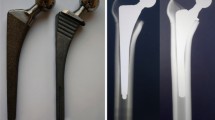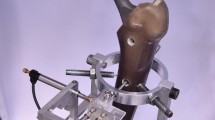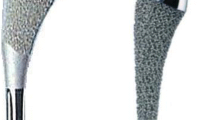Abstract
Purpose
The aim of this study is to quantitatively compare the difference in primary stability between collarless and collared versions of the same femoral stem. Specifically, we tested differences in subsidence and micromotion.
Methods
Collarless and collared versions of the same cementless femoral stem were implanted in two groups of six fresh-frozen cadaveric femurs. Each implanted femur was then subsequently tested for axial compressive and torsional loadings. A micro-CT based technique was applied to quantify implant subsidence and compute the map of local micromotion around the femoral stems. Micromotion of collarless and collared stems was compared in each Gruen zone.
Results
Subsidence was higher but not significantly (p = 0.352) with collarless (41.0 ± 29.9 μm) than with collared stems (37.0 ± 44.6 μm). In compression, micromotion was lower (p = 0.257) with collarless (19.5 ± 5 μm) than with collared stems (43.3 ± 33.1 μm). In torsion, micromotion was also lower (p = 0.476) with collarless (96.9 ± 59.8 μm) than collared stems (118.7 ± 45.0 μm). Micromotion was only significantly lower (p = 0.001) in Gruen zone 1 and for compression with collarless (7.0 ± 0.6 μm) than with collared stems (22.6 ± 25.5 μm).
Conclusions
Primary stability was achieved for both stem designs, with a mean micromotion below the osseointegration threshold. Under loading conditions similar to those observed in normal daily activity and with good press-fit, the collar had no influence on subsidence or micromotion. Further studies are required to test the potential advantage of collar with higher loads, undersized stems, or osteoporotic femurs.





Similar content being viewed by others
References
Jasty M, Bragdon CR, Zalenski E et al (1997) Enhanced stability of uncemented canine femoral components by bone ingrowth into the porous coatings. J Arthroplast 12:106–113. doi:10.1016/S0883-5403(97)90055-3
Soballe K, Hansen ES, B-R H et al (1992) Tissue ingrowth into titanium and hydroxyapatite-coated implants during stable and unstable mechanical conditions. J Orthop Res 10:285–299
Hutt J, Hazlerigg A, Aneel A et al (2014) The effect of a collar and surface finish on cemented femoral stems: a prospective randomised trial of four stem designs. Int Orthop 38:1131–1137. doi:10.1007/s00264-013-2256-z
Demey G, Fary C, Lustig S et al (2011) Does a collar improve the immediate stability of Uncemented femoral hip stems in Total hip arthroplasty? A bilateral comparative cadaver study. J Arthroplast 26:1549–1555. doi:10.1016/j.arth.2011.03.030
Ebramzadeh E, Sangiorgio SN, Longjohn DB et al (2004) Initial stability of cemented femoral stems as a function of surface finish, collar, and stem size. J Bone Jt Surg Am 86–A:106–115
Mandell JA, Carter DR, Goodman SB et al (2004) A conical-collared intramedullary stem can improve stress transfer and limit micromotion. Clin Biomech 19:695–703. doi:10.1016/j.clinbiomech.2004.04.004
Gortchacow M, Wettstein M, Pioletti DP, Terrier A (2011) A new technique to measure micromotion distribution around a cementless femoral stem. J Biomech 44:557–560. doi:10.1016/j.jbiomech.2010.09.023
Gortchacow M, Wettstein M, Pioletti DP et al (2012) Simultaneous and multisite measure of micromotion, subsidence and gap to evaluate femoral stem stability. J Biomech 45(7):1232–1238. doi:10.1016/j.jbiomech.2012.01.040
Malfroy Camine V, Rüdiger HA, Pioletti DP, Terrier A (2016) Full-field measurement of micromotion around a cementless femoral stem using micro-CT imaging and radiopaque markers. J Biomech 49:4002–4008. doi:10.1016/j.jbiomech.2016.10.029
Bergmann G, Graichen F, Rohlmann A et al (2010) Realistic loads for testing hip implants. Biomed Mater Eng 20:65–75. doi:10.3233/BME-2010-0616
Gruen TA, McNeice GM, Amstutz HC (1979) “Modes of failure” of cemented stem-type femoral components: a radiographic analysis of loosening. Clin Orthop 17–27
Jameson SS, Baker PN, Mason J et al (2013) Independent predictors of failure up to 7.5 years after 35 386 single-brand cementless total hip replacements: a retrospective cohort study using National Joint Registry data. Bone Jt J 95 B:747–757. doi:10.1302/0301-620X.95B6.31378
Meding JB, Ritter MA, Keating EM, Faris PM (1997) Comparison of collared and collarless femoral components in primary uncemented total hip arthroplasty. J Arthroplast 12:273–280. doi:10.1016/S0883-5403(97)90023-1
Bergmann G, Bender A, Dymke J et al (2016) Standardized loads acting in hip implants. PLoS One 11(5):e0155612. doi:10.1371/journal.pone.0155612
Bieger R, Ignatius A, Decking R et al (2012) Primary stability and strain distribution of cementless hip stems as a function of implant design. Clin Biomech 27:158–164. doi:10.1016/j.clinbiomech.2011.08.004
Fottner A, Peter CV, Schmidutz F et al (2011) Biomechanical evaluation of different offset versions of a cementless hip prosthesis by 3-dimensional measurement of micromotions. Clin Biomech 26:830–835. doi:10.1016/j.clinbiomech.2011.04.001
Engh CA, O’Connor D, Jasty M, et al (1992) Quantification of implant micromotion, strain shielding, and bone resorption with porous-coated anatomic medullary locking femoral prostheses. Clin Orthop Relat Res 285:13–29
Pilliar RM, Lee JM, Maniatopoulos C (1986) Observations on the effect of movement on bone ingrowth into porous-surfaced implants. Clin Orthop Relat Res 208:108–113
Enoksen CH, Gjerdet NR, Klaksvik J et al (2014) Initial stability of an uncemented femoral stem with modular necks. An experimental study in human cadaver femurs. Clin Biomech 29:330–335. doi:10.1016/j.clinbiomech.2013.12.011
Kassi J-P, Heller MO, Stoeckle U et al (2005) Stair climbing is more critical than walking in pre-clinical assessment of primary stability in cementless THA in vitro. J Biomech 38:1143–1154. doi:10.1016/j.jbiomech.2004.05.023
Østbyhaug PO, Klaksvik J, Romundstad P, Aamodt A (2010) Primary stability of custom and anatomical uncemented femoral stems. Clin Biomech 25:318–324. doi:10.1016/j.clinbiomech.2009.12.012
Kang Q, An YH, Friedman RJ (1997) Effects of multiple freezing-thawing cycles on ultimate indentation load and stiffness of bovine cancellous bone. Am J Vet Res 58:1171–1173
Linde F, Sørensen HCF (1993) The effect of different storage methods on the mechanical properties of trabecular bone. J Biomech 26:1249–1252. doi:10.1016/0021-9290(93)90072-M
Author information
Authors and Affiliations
Corresponding author
Ethics declarations
Conflict of interest
This study was founded by the Swiss National Science Foundation (#141152) and by the SwissLife Jubiläumstiftung. The funding source did not play a role in the investigation. Each author certifies that he or she, or a member of his or her immediate family, has no funding or commercial associations (e.g. consultancies, stock ownership, equity interest, patent/licensing arrangements, etc.) that might pose a conflict of interest in connection with the submitted article.
Ethical review committee statement
Each author certifies that his or her institution approved or waived approval for the human protocol for this investigation and that all investigations were conducted in conformity with ethical principles of research. This study was performed in accordance with the ethical standards in the 1964 Declaration of Helsinki. The local ethical committee approval is not required for biomechanical test on human cadaveric bones.
This work was performed at the Ecole Polytechnique Fédérale de Lausanne and the Lausanne University Hospital, Lausanne, Switzerland.
Rights and permissions
About this article
Cite this article
Malfroy Camine, V., Rüdiger, H.A., Pioletti, D.P. et al. Effect of a collar on subsidence and local micromotion of cementless femoral stems: in vitro comparative study based on micro-computerised tomography. International Orthopaedics (SICOT) 42, 49–57 (2018). https://doi.org/10.1007/s00264-017-3524-0
Received:
Accepted:
Published:
Issue Date:
DOI: https://doi.org/10.1007/s00264-017-3524-0




